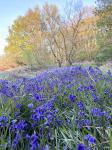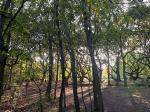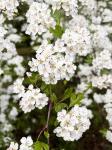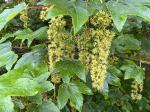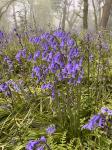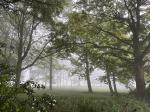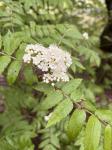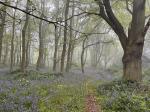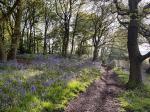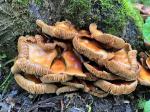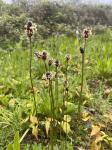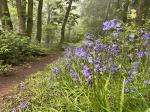Brayton Barff Through the Seasons.
Set in the Vale of York, South West of the market town of Selby and between the villages of Thorpe Willoughby and Brayton, lies Brayton Barff, a sandstone Hill approximately one hundred and fifty feet in height which was formed by glacial movement during the last Ice Age. It is a significant landmark in an otherwise flat landscape.
Today the site is primarily owned by Yorkshire Water with Selby District Council owning a small patch of the land adjacent to the A63 Selby bypass. A large underground reservoir occupies the centre of the site which delivers water to around 4.7 million customers throughout Yorkshire.
Within the Barff woodland over 40% of the trees are Sessile Oak which are generally found in semi natural woodlands in the north of the country. These trees are so called because its acorns are not held on stalks, like those of the English Oak (Pedunculate), but attached directly to the outer twigs. There are also several English Oak trees as well as some cross-hybrid oaks. These trees are known to support many species of flora and fauna, invertebrates, mosses, lichen and fungi.
During the Victorian times it is thought that the shipbuilders on the east coast would come over to the Barff for selected cuts of timber to build their sea going vessels.
The Barff also has a variety of other trees including Silver Birch, Beech, Sycamore, Holly, Rowan, Scots Pine, Alder, Hawthorne and European Larch. There are also several Yew, Willow, Hazel, Horse Chestnut and Wych Elm. As with similar woodlands there are a variety of bushes, including Honeysuckle, Elderberry, Gorse, Broom and Buddleia.
The history of Brayton Barff is quite vague, apparently during 1803 a beacon was lit on the Barff when the country was threatened with an invasion by Napoleon. In May 1935, to celebrate King George V's Silver Jubilee, a Bonfire was lit on the Barff as part of the celebrations.
Early issues of Ordnance Survey Maps dated 1903 clearly show a rifle range on the Barff, extending out to Mill Lane. During the 
Between 2001 – 2004 the A63 Selby bypass, 10km twin lane single carriageway was constructed which severed the South West corner of the Barff, adjacent to Selby Golf Course and resulted in a slight redesign of several holes on the golf course. Wooden fencing was erected as a result of this new road running alongside of the Barff and a footbridge constructed over the ‘new road’ following the line of the Bridal way which extends from Mill Lane. Around 2005/2006 a definite 2metre wide limestone aggregate footpath was laid forming a circular path around the outer edges of the woodland. This footpath is approximately 1.2 miles in length and takes about 30 minutes to circumnavigate at a leisurely pace.
In 2012 the Barff was declared an Ancient Oak Woodland and as such throughout 2012 and 2013 significant work had been carried out by the relevant agencies to cut and remove large swathes of non-native trees, creating at that time huge scars on the landscape. Some three years later the planting of the native trees have become well established and are flourishing. Ongoing maintenance work on the footpath around the bottom of the Barff was completed during the Summer of 2016.
A second phase of woodland maintenance commenced during the Autumn of 2019 with the removal of many old and diseased trees and the cutting back of the Gorse and Broom bushes, especially adjacent to the ‘bypass trail’, this work continued through till March 2020 with re planting continuing into April 2020.
Brayton Barff is a popular site for walkers and bird watchers alike and a path circling the outer perimeter of the Barff makes a pleasant thirty minute walk, giving views looking over towards Selby and the village of Brayton as well as the power stations of Drax and Eggborough..jpg)
For the early risers it is a great place to see some stunning sunrises over the villages of Brayton looking towards Drax Power Station, the same with the Sunsets looking over towards Eggborough and Monk Fryston.
The Barff changes with the Seasons and every visit can reveal something new, the woodland is a haven for wildlife. Records show that since 1982 one hundred and twelve species of bird have been seen in the woodland and at least 40 of those have bred here, including Tawny Owl, Buzzard, Green Woodpecker, Spotted Flycatcher, Goldcrest and Nuthatch to name just a few. On average over 70 species of bird are recorded each year. Further details of the bird life on the Barff can be found on the Brayton Barff Group Facebook page, especially the posts from Derek Cooper. Today ‘The Friends of Brayton Barff group’ led by Derek and a small team of volunteers help keep and maintain the cleanliness of the site as well as recording the wildlife and bird sightings.
The Barff is also home to fifteen different species of mammals, including Muntjac Deer, Pipistrelle Bat, Fox, and Field Vole.
Over eighty species of plant and wildflowers have been recorded, included Bee Orchid, Northern Marsh Orchid, Wood Anemone, Marsh Ragwort, Bluebell, White Bluebell, Bittersweet and Purple and White Foxgloves. Over twenty species of Butterfly have been recorded, including Marbled White, Brown Angus, Speckled Wood, Comma and Brimstone.
During the Autumnal months fungi thrives in this woodland environment, species including Fly Agaric, Beefsteak Tree Fungi, Chicken of the Wood, Sulphur Tufts, Stinkhorn, Ink cap, Puffballs and Hoof Bracket are just some of the many varieties that can be found here.
Click on the galleries shown below to expand the albums.
May 2023
It has been a good year for the Bluebells on the Barff, that said, they were probably at their best towards the end of April and the first week in May, as I write this note towards the end of the month, they have all but died back or been smothered by the emerging ferns, nettles and Sycamore seedlings.
With the longer days and warmer temperatures, the woodland is looking exceptionally lush and green. Rowan trees are full of blossom, as are the Sycamore trees, even the Holly bushes are full of florets. The Hawthorn bushes are in full flower along with the Elderberry bushes, although they are several weeks behind. Blackthorn bushes which flowered last month are now laden with fruit (Sloes), especially along both sides of the Bypass trail and the several apple trees are also full of blossom too. The Dogwood bushes are full of blossom too.
The field of Oilseed rape adjacent to the old pumping station has been a picture this year, though as the month comes to an end the yellow florets are beginning to fade.
As we move into June the Gorse bushes too are losing their yellow florets and are beginning to turn to seed. They have been in flower though throughout the winter months and been a valuable food source for the insects.
The birdlife continues apace, Greater Spotted Woodpeckers have been noticeably quiet but very busy feeding their chicks, I’ve watched several of them bringing flies and grubs back to their hungry youngsters, you can hear the ‘noisy trees’ when you walk past them as you make your way around the woodland, some of their nest sites being next to the perimeter footpath.
I have seen at least two nesting pairs of Nuthatches, they too have been relatively quiet (not so vocal) whilst they busily rear their chicks, continuously taking food into their nest boxes and removing the debris and waste material.
Song Thrush, Black Caps and Dunnock all very vocal and can be heard and seen most mornings, along with Wren, Robins, Blue & Great Tits, and Long Tailed Tits, just to name a few.
One of the highlights of May on the Barff has been the birth of the Tawny Owl chicks. I am aware of at least three families of Tawnies, one pair has had four chicks, another pair three chicks alas only two chicks now, and the third pair two chicks. The Owlets are currently out of their nest sites and ‘Branching,’ still under the watchful eyes of their parents, being totally dependent on their parents for food they will stay close to their parents for anything up to three months depending on the supply of food. As the leaf cover increases it makes it harder by the day to keep an eye on them. One of the reasons for such a productive year can be put down to the healthy food chain on the Barff, I wrote several months ago of an abundance of vole holes on the Barff as well as an excessive amounts of worms, all of which form the staple diet of the Tawny owls and Buzzards.
Our pair of resident Buzzards have been more active than usual this month, the male Buzzard has been performing its impressive aerial display known as “The Roller Coaster”, as he flies straight up, then flips around and speeds downwards towards the Earth, all the while spiralling and twisting. He then swoops back up again and continues the display all to impress his girlfriend.
They usually build a large nest around the summit of the Barff and is mainly made of twigs and branches and lined with moss and other green material. They usually lay between two to three eggs which hatch after around 35 days. The young fledge after roughly two months but may be fed by their parents for several more weeks. Let’s hope they are able to successfully rear their young.
The Bridal path (Bypass Trail) is getting heavily overgrown with saplings, brambles, Blackthorn bushes and nettles. I wouldn’t want to lead my horse down there until it is cut back somewhat, that said the council have been down there once with a small grass cutter, they now need to get down there with a big tractor and hedge trimmer to cut back all the brambles.
Wildflowers have come on a pace this month, Foxgloves seem to have grown by a metre, the warmer weather giving them a growth spurt and are now in flower, providing an additional food source for our bees. Ragged Robin is flowering nicely on the Barff summit. Red and White Campion has started to flower, their delicate florets providing a welcome source on nourishment for the Barff’s insect population. Germander Speedwell is another low-growing plant and has been flowering nicely for some time, its bright blue flowers with four petals and a white middle are often known as ‘Birds eye’ or ‘Cats Eye’ and the bees love them.
The umbrella-like clusters of white, frothy flowers of cow parsley are a familiar sight amongst our woodland and especially around the perimeter footpath. It has large, flat umbrellas of small, white flowers, and large, fern-like leaves. It is a member of the carrot family. It is attractive to a huge number of creatures, from orange-tip butterflies to marmalade hoverflies, and even rabbits.
Dandelions have continued to flourish on the Barff, along with Creeping buttercups, again both useful plants for our insect population.
Himalayan Balsam has taken a strong hold again around the woodland, in places it is getting on for one and a half metres in hight and flowering, this invasive weed is quite a menace as it prevents all our native plants from growing.
The longer days have been welcomed, Sunrise on 1st May was 5.30am and by the end of the month be around 4.30am with Sunset around 8.30pm/9.30pm. Average morning temperatures have been around 8c – 12c, with the afternoon temperatures varying between 18c – 20c. Overall I’ve had some very pleasant dry, early morning walks with Meg & Gracie. The overnight temperatures have dropped to single figures resulting in some heavy dewy mornings but overall, they have remained dry. The footpaths around the woodland have dried up nicely. We have experienced several cold days with a cool easterly wind coming off the North Sea which kept the temperatures down a little, but the high pressure of late has seen afternoon temperatures range between 18C – 22C. May has been a frost-free month.
Overnight on Sunday 21st May a ‘spring’ (or burst pipe) looks to have burst on one of the smaller tracks which runs adjacent to the perimeter track near to the old pumping station, turning the track into a muddy trail, the water was coming over my footwear, and as the week progressed the flow of water increased making the trail unpassable in ordinary footwear and by Saturday 27th the water was cutting across the perimeter footpath and into the adjoining fields and paddock of the Old pump house. I wonder how long it will take for Yorkshire Water to fix it?
It was nice to be able to watch a pair of deer contently grazing in the paddock of the old pump house recently, completely unaware of my presence, though whether the owners of this now residential building feel the same I don’t know.
A pair of foxes have been making quite a commotion playfighting on the Barff just recently, more so during the evenings, something I haven’t heard for a long while, their loud screeching sounds making quite a racket in the woodland. They usually breed during the winter months and have their babies during the warmer Spring months, so the milder, warmer weather is making them somewhat frisky and boisterous.
It has been nice to see some Hebridean sheep with the horses in ‘Sherwood’s field’ adjacent to the Barff, I don’t know why but I seem to have got into the habit of counting them every morning as we walk past them, they are either snoozing or contently grazing on the lush grass.
|

